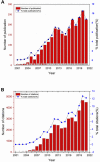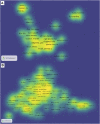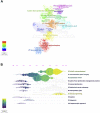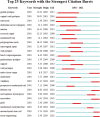Knowledge mapping and visualization analysis of pelvic organ prolapse repair with mesh from 2001 to 2021
- PMID: 37091336
- PMCID: PMC10113510
- DOI: 10.3389/fbioe.2023.1104724
Knowledge mapping and visualization analysis of pelvic organ prolapse repair with mesh from 2001 to 2021
Abstract
Aims: In recent decades, extensive attention has been paid to the application of mesh to repair pelvic floor defects. However, a large body of related literature has not been system summarized. The purpose of this study is to summarize and visualize the literature on pelvic organ prolapse (POP) repair with mesh using bibliometrics. Methods: Medical literature regarding POP repair with mesh were searched and obtained in the Web of Science™ Core (WoSCC) database from 2001 to 2021. Microsoft Excel 2020, CiteSpace and VOSviewer were used to conduct the bibliometric and knowledge-map analysis. Results: In the past 20 years, a total of 2,550 articles and reviews have been published in 35 journals, and the published and cited results show a growing trend. Cosson M and International Urogynecology Journal were the authors and journals with the highest output, respectively. The United States, France and the United Kingdom are among the top three countries/organizations in relevant publications in worldwide. 584 key words in the literature are divided into 8 clusters, which are mainly related to prolapse type, risk factors, surgical methods, imaging, quality of life and bioengineering. Using clinical research and tissue engineering technology to reduce mesh complications is the current hot spot in this field. Conclusion: Reasonable application of mesh and avoiding mesh complications are still the most concerned topics in POP research. Although clinical research, surgical improvement, biological mesh and bioengineering technology have shown promising results, it is still urgent to carry out clinical transformation application research.
Keywords: bibliometric analysis; citation; hotspots; mesh; pelvic organ prolapse.
Copyright © 2023 Zhou, Lu, Li, Peng and Song.
Conflict of interest statement
The authors declare that the research was conducted in the absence of any commercial or financial relationships that could be construed as a potential conflict of interest.
Figures








Similar articles
-
Top 100 most-cited articles on pelvic organ prolapse: a visualization and bibliometric analysis.Front Surg. 2025 Mar 28;12:1485426. doi: 10.3389/fsurg.2025.1485426. eCollection 2025. Front Surg. 2025. PMID: 40225115 Free PMC article.
-
Bibliometric Analyses of the Research Trends of Female Pelvic Organ Prolapse.Int Urogynecol J. 2024 Jun;35(6):1281-1290. doi: 10.1007/s00192-024-05812-5. Epub 2024 May 17. Int Urogynecol J. 2024. PMID: 38758456
-
A bibliometric and social network analysis of pelvic organ prolapse during 2007-2016.J Chin Med Assoc. 2018 May;81(5):450-457. doi: 10.1016/j.jcma.2017.08.012. Epub 2017 Oct 9. J Chin Med Assoc. 2018. PMID: 29033114
-
A bibliometric analysis on laparoscopic pelvic floor surgery from 1996-2022.Eur J Obstet Gynecol Reprod Biol. 2024 Oct;301:264-270. doi: 10.1016/j.ejogrb.2024.08.018. Epub 2024 Aug 13. Eur J Obstet Gynecol Reprod Biol. 2024. PMID: 39181029
-
Emerging trends on the mechanism of pelvic organ prolapse from 1997 to 2022: visualization and bibliometric analysis.Front Med (Lausanne). 2023 Jun 7;10:1158815. doi: 10.3389/fmed.2023.1158815. eCollection 2023. Front Med (Lausanne). 2023. PMID: 37351071 Free PMC article.
Cited by
-
Top 100 most-cited articles on pelvic organ prolapse: a visualization and bibliometric analysis.Front Surg. 2025 Mar 28;12:1485426. doi: 10.3389/fsurg.2025.1485426. eCollection 2025. Front Surg. 2025. PMID: 40225115 Free PMC article.
-
Scientific landscape and visualization analysis of the link between adenomyosis and infertility from 2000 to 2024.Front Med (Lausanne). 2025 Feb 19;12:1488866. doi: 10.3389/fmed.2025.1488866. eCollection 2025. Front Med (Lausanne). 2025. PMID: 40046932 Free PMC article.
-
Bibliometric Analyses of the Research Trends of Female Pelvic Organ Prolapse.Int Urogynecol J. 2024 Jun;35(6):1281-1290. doi: 10.1007/s00192-024-05812-5. Epub 2024 May 17. Int Urogynecol J. 2024. PMID: 38758456
References
-
- Adhoute F., Soyeur L., Pariente J. L., Le Guillou M., Ferriere J. M. (2004). Use of transvaginal polypropylene mesh (Gynemesh) for the treatment of pelvic floor disorders in women. Prospective study in 52 patients. Prog. Urol. 14 (2), 192–196. - PubMed
-
- American College of O, Gynecologists, the American Urogynecologic S, Food IUTPBiuahtrtU (2019). Drug Administration order to stop the sale of transvaginal synthetic mesh products for the repair of pelvic organ p. Pelvic Organ Prolapse. Female Pelvic Med. Reconstr. Surg. 25 (6), 397–408. - PubMed
LinkOut - more resources
Full Text Sources
Miscellaneous

